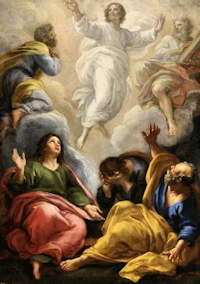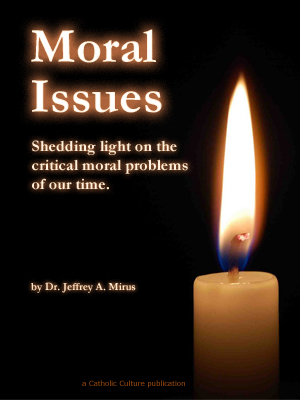» Enjoy our Liturgical Seasons series of e-books!
Jesus answered them and said, "Amen, amen, I say to you, you are looking for me not because you saw signs but because you ate the loaves and were filled. Do not work for food that perishes but for the food that endures for eternal life, which the Son of Man will give you. For on him the Father, God, has set his seal." So they said to him, "What can we do to accomplish the works of God?" Jesus answered and said to them, "This is the work of God, that you believe in the one he sent (John 6:26-30)."
The Transfiguration
Our divine Redeemer, being in Galilee about a year before His sacred Passion, took with him St. Peter and the two sons of Zebedee, Sts. James and John, and led them to a retired mountain. Tradition assures us that this was Mount Thabor, which is exceedingly high and beautiful, and was anciently covered with green trees and shrubs, and was very fruitful. It rises something like a sugar-loaf, in a vast plain in the middle of Galilee. This was the place in which the Man-God appeared in His glory.
Whilst Jesus prayed, he suffered that glory which was always due to his sacred humility, and of which, for our sake, He deprived it, to diffuse a ray over His whole body. His face was altered and shone as the sun, and his garments became white as snow. Moses and Elias were seen by the three apostles in his company on this occasion, and were heard discoursing with him of the death which he was to suffer in Jerusalem.
The three apostles were wonderfully delighted with this glorious vision, and St. Peter cried out to Christ, "Lord, it is good for us to be here. Let us make three tents: one for thee, one for Moses, and one for Elias" Whilst St. Peter was speaking, there came, on a sudden, a bright shining cloud from heaven, an emblem of the presence of God's majesty, and from out of this cloud was heard a voice which said, "This is my beloved Son, in whom I am well pleased; hear ye him" The apostles that were present, upon hearing this voice, were seized with a sudden fear, and fell upon the ground; but Jesus, going to them, touched them, and bade them to rise. They immediately did so, and saw no one but Jesus standing in his ordinary state.
This vision happened in the night. As they went down the mountain early the next morning, Jesus bade them not to tell any one what they had seen till he should be risen from the dead.
—Excerpted from Butler's Lives of the Saints, Benziger Bros. ed. [1894]
In the Transfiguration Christ enjoyed for a short while that glorified state which was to be permanently His after His Resurrection on Easter Sunday. The splendor of His inward Divinity and of the Beatific Vision of His soul overflowed on His body, and permeated His garments so that Christ stood before Peter, James, and John in a snow-white brightness. The purpose of the Transfiguration was to encourage and strengthen the Apostles who were depressed by their Master's prediction of His own Passion and Death. The Apostles were made to understand that His redeeming work has two phases: The Cross, and glory—that we shall be glorified with Him only if we first suffer with Him.
—Rt. Rev. Msgr. Rudolph G. Bandas
Patronage: pork butchers; Borgomasino, Italy
Highlights and Things to Do:
- Read more about the Transfiguration:
- Visit virtually the Church of the Transfiguration located on Mount Tabor in Israel.
- See the Altar of Transfiguration in St. Peter's Basilica.
- In the Russian Orthodox church, honey, pears, apples, plums and other fruits are brought to the church for blessing. This feast is also referred to as "Metamorphosis" in the Eastern church.
- The Transfiguration was another "firstfruits" harvest feast, particularly of grapes and wheat. The older Roman Ritual has a blessing of grapes and blessing of the harvest for this feast.
- Playing up on the brilliant white of the garments, decorating with white (tablecloth, candles, etc.) and serving some white foods (mashed potatoes, vanilla ice cream, Mexican wedding cookies, meringues, etc.) can bring to mind that dazzling white.
- This is one of the harvest feasts of the Church. Katherine Burton in her Feast Day Cookbook explains the grape and wine connection for the Transfiguration: "Traditionally on the Feast of the Transfiguration, the Pope presses a bunch of ripe grapes into the chalice at Mass or uses new wine. Also in Rome raisins are blessed on the Feast of the Transfiguration, and the Greek and Russian Churches to conduct a special ceremony for blessing grapes and other fruits. See the recipe for spiced grape jelly and Toasting Through the Liturgical Year for more details. See also Catholic Cuisine for other ideas.
- Having Moses and Elijah at the Transfiguration is a reminder of the Old Testament. Bring in some Jewish recipes or foods to highlight this aspect of the feast day.
- View some paintings of the Transfiguration here.






